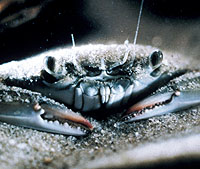Chesapeake Bay Restoration Tracked with GIS Accountability Tool
ChesapeakeStat on ArcGIS Server Provides Insight about Action Plan Status
July 7, 2010
Redlands, California—The Chesapeake Bay Program (CBP) has launched ChesapeakeStat, a management and accountability tool. Esri and CBP developed the geographic information system (GIS)-enabled Web site that provides the public, decision makers, and restoration stakeholders with up-to-date information about the progress of government-funded restoration and conservation projects for the Chesapeake Bay watershed.
Built partly on ArcGIS Server, ChesapeakeStat includes a public Web site that promotes accountability, fosters coordination, and increases transparency by sharing performance information on goals, indicators, strategies, and funding. CBP partners also use the site for analyzing information and data so they can better assess progress toward goals and adapt new strategies and tactics.
"Esri has been instrumental in developing the successful StateStat and BayStat models that Maryland developed under the leadership of governor Martin O'Malley," explains John Wolf, U.S. Geological Survey (USGS) and GIS team leader of CBP. "It was a natural step to work with Esri staff in the design of our project. GIS is a tool for showing people what agencies are doing and how they are spending money. But this project takes it a step further. People can see in a geographic context how an agency's goals, strategies, and outcomes are being accomplished."
ChesapeakeStat was created to provide an open and transparent way to assess and show progress toward restoration goals and adapt the CBP partnership approach when needed. The development of ChesapeakeStat was also called for in the Strategy for Protecting and Restoring the Chesapeake Bay Watershed, developed in response to President Barack Obama's Executive Order 13508, issued in May 2009.
ChesapeakeStat organizes information around the CBP goal areas of sustainable fisheries, healthy habitats, water quality, healthy watersheds, and Chesapeake stewardship. By selecting from tabs for performance measures, strategies, priorities, actions, and funding, each of the program's goal areas can be further drilled into to show data about specific topics and issues. A person using ChesapeakeStat will eventually be able to zoom in to an area and see the watershed's hot spots, then drill down into smaller watershed units to see what is happening in specific areas.
"The Chesapeake Bay affects 64,000 square miles of habitat and 17 million people. Restoration efforts are crucial," says Robin Smith, Ph.D., Esri's environmental management solutions manager. "Esri is highly supportive of CBP's ChesapeakeStat model. It makes government information easily discoverable and simple to use. Using GIS to track expenditures and progress is another step forward in geoenabling government programs to meet their goals."
The site meets various levels of consumer need. The public and media may only want to see aggregated interpreted data for general information, whereas a scientist can access highly detailed data for research. Local watershed groups can use the site to better understand how their actions relate to the overall restoration efforts for the bay. A government agency may want to use the site as an adaptive management tool to evaluate success and decide if resources should be shifted from one location to another or possibly even from one program to another.
# # #
Press Information:
Barbara Shields, Esri
Tel.: 909-793-2853, extension 1-2641
E-mail (press only): press@esri.com
General Information: info@esri.com
